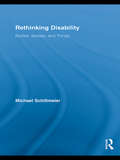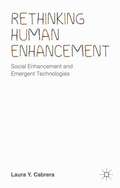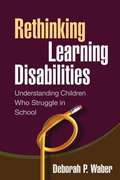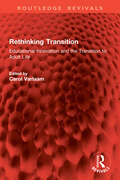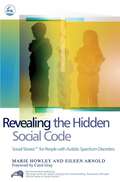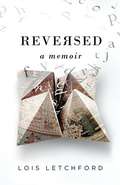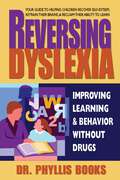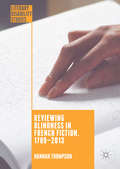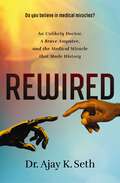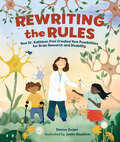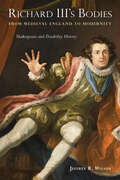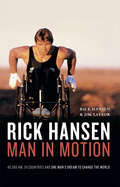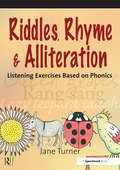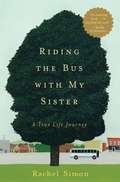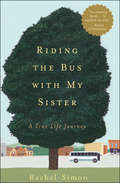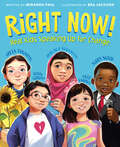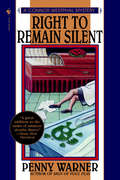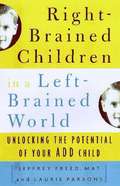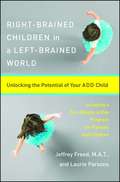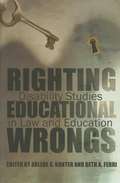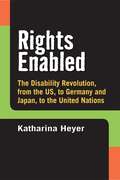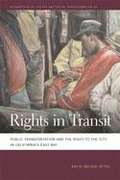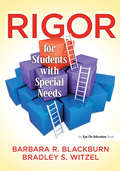- Table View
- List View
Rethinking Disability: Bodies, Senses, and Things (Routledge Studies in Science, Technology and Society)
by Michael SchillmeierThis text is a critical and empirically-based introduction to disability studies. It offers a comprehensive, book-length analysis of disability through the lens of Science and Technology Studies (STS), and presents a practice-oriented discussion of how bodies, senses and things are linked in everyday life and configure "enabling" and "disabling" scenarios. Relevant to a broad spectrum of medical practitioners and practicing social service workers, the book will also be essential reading in the fields of disability studies, sociology of the body/senses, medical sociology and STS.
Rethinking Human Enhancement: Social Enhancement and Emergent Technologies
by Laura Y. CabreraThis book discusses three possible human enhancement paradigms and explores how each involves different values, uses of technology, and different degrees and kinds of ethical concerns. A new framework is advanced that promotes technological innovation that serves the improvement of the human condition in a respectful and sustainable way.
Rethinking Learning Disabilities: Understanding Children Who Struggle in School
by Deborah WaberExperts have yet to reach consensus about what a learning disability is, how to determine if a child has one, and what to do about it. Leading researcher and clinician Deborah Waber offers an alternative to the prevailing view of learning disability as a problem contained within the child. Instead, she shows how learning difficulties are best understood as a function of the developmental interaction between the child and the world. Integrating findings from education, developmental psychology, and cognitive neuroscience, she offers a novel approach with direct practical implications. Detailed real-world case studies illustrate how this approach can promote positive outcomes for children who struggle in school.
Rethinking Transition: Educational Innovation and the Transition to Adult Life (Routledge Revivals)
by Carol VarlaamIn the early 1970s, nearly three-quarters of 16–19-year-olds were employed. First published in 1984, Rethinking Transition comprises a collection of papers based on the evaluation of a group of projects concerned with the problems faced by young people in the transition from school to working life. The projects were funded by the European Economic Commission, the Department of Education and Science and various Education Authorities in England and Wales.
Retrolental Fibroplasia and Autistic Symptomatology: An Investigation into Some Relationships Among Neonatal, Environmental, Developmental and Affective Variables in Blind Prematures
by Joan B. ChaseIn this monograph, based on a study of 263 subjects with RLF (Retrolental Fibroplasia-- an eye condition caused by excessive incubator oxygen), the author examines selected variables which may significantly affect subsequent development.
Revealing the Hidden Social Code: Social Stories (TM) for People with Autistic Spectrum Disorders
by Marie Howley Eileen ArnoldThe Social Stories(TM) approach is widely acknowledged as a key technique for teaching social and life skills to children with autistic spectrum disorders. This text, endorsed by the originator of Social Stories(TM), Carol Gray, offers clear and comprehensive guidance for professionals, parents and carers on how to write successful and targeted Social Stories(TM) that will help develop the autistic spectrum child's understanding of social interaction. The book outlines the kinds of social challenges that people with ASD may experience and highlights the importance of learning social skills in meaningful contexts. An extended review of the guidelines for writing Social Stories(TM) will help writers to structure and develop their stories. The authors explain the key elements and highlight the potential difficulties that a writer may encounter, while providing encouragement and guidance through the various stages of what is often a challenging process. They include examples from their own professional experience, and suggest ways in which the Social Stories(TM) approach may enhance other strategies. Helpful advice on presentation and implementation is provided. Revealing the Hidden Social Code is essential reading for any professional, parent, carer or teacher wanting to employ Social Stories(TM) to develop social understanding in people with ASDs.
Reversed: A Memoir
by Lois LetchfordIn 1995, the school diagnostician called a seven-year-old, “The worst child seen in 20 years of teaching.” Can a child’s fate be sealed by such a diagnosis? Well, in 2018, that boy received a Ph.D. from Oxford University. <P> Do you have a child struggling with reading? What labels has your child been given? How do you feel they will progress through school? This is a story for you. <P> Every parent has high hopes for their children. When Lois Letchford learns her son has been diagnosed with a low IQ at the end of grade one, she refuses to give up on his future. After thorough testing, Nicholas proves to have no spatial awareness, limited concentration, and can only read ten words. Although discouraged, Lois knows things have to improve. After all, her son is young, and every child learns at their own pace. But once Nicholas is labeled "learning disabled," a designation considered more derogatory than "dyslexia," the world of education is quick to cast him aside. <P> Determined to prove them all wrong, Lois temporarily removes her son from the school system and begins working with him one-on-one. She has no formal reading education herself, and no one to guide her. But she has hope and the strength of will to persevere. And sometimes that's all you need. What happens next is a journey—spanning three continents, unique teaching experiments, never-ending battles with the school system, a mother’s discovery of her own learning blocks, and a bond fueled by the desire to rid Nicholas of the “disabled” label. <P> "Reversed" is a memoir of profound determination that follows the highs and lows of overcoming impossible odds, turning one woman into a passionate teacher for children who have been left behind. Nothing is impossible when one digs deep, and looks at students through a new lens.
Reversing Dyslexia
by Dr Phyllis BooksMost people do not realize that dyslexia is more than just a reading problem. It is often accompanied by social, psychological, and even physical issues that can make many everyday tasks seem unmanageable. Whether you suffer from dyslexia yourself or are the parent of a dyslexic child, dealing with the overall challenges of this learning disorder can be overwhelming. Unfortunately, mainstream treatment focuses mainly on compensatory techniques and workarounds, not a cure, leaving dyslexics feeling hopeless and stuck. In her new book, Dr. Phyllis Books offers a new approach to dyslexia and a convincing reason to hope again. Drawing upon her vast experience and a wealth of scientific research, she declares that dyslexia can actually be reversed in a large number of cases. <P><P> Reversing Dyslexia begins by redefining dyslexia, offering the most comprehensive view of this problem yet. It describes dyslexia’s common symptoms, lists its associated conditions, and details the many theories that surround this issue. It goes on to explain how the brain develops, revealing how an improperly functioning brain may be rewired and repaired through the right combination of therapies, all of which are described in detail. It then shows how important nutrition, exercise, play, and music are to learning ability, and concludes with invaluable advice on how to choose the right school for your dyslexic child. <P><P> By providing a modern perspective on dyslexia, this book lays the groundwork for significant improvements not only in reading but also in general learning ability, emotional stability, and psychological well-being. Having worked with thousands of children, parents, and educators, Dr. Books has spent over twenty-five years disproving the idea that dyslexia is a permanent condition. Reversing Dyslexia can teach you how to disprove it as well.
Reviewing Blindness in French Fiction, 1789–2013
by Hannah ThompsonThis book argues that the most interesting depictions of blindness in French fiction are those which call into question and ultimately undermine the prevailing myths and stereotypes of blindness which dominate Western thought. Rather than seeing blindness as an affliction, a tragedy or even a fate worse than death, the authors examined in this study celebrate blindness for its own sake. For them it is a powerful artistic and creative force which offers new and surprising ways of describing, and relating to, reality. Canonical and lesser-known novels from a range of genres, including the roman noir, science fiction, auto-fiction and realism are analyzed in detail to show how the presence of blind characters invites the reader to abandon his or her traditional reliance on the sense of sight and engage with the world in sensual, and hitherto unexpected, ways. This book challenges everything we thought we knew about blindness and invites us to revel in the pleasures and perils of reading blind.
Rewired: An Unlikely Doctor, a Brave Amputee, and the Medical Miracle That Made History
by Dr. Ajay SethA raccoon bite on the arm doesn&’t seem that serious, but it soon becomes a life-or-death medical crisis for Melissa Loomis. After days of treatment for recurring infection, it becomes obvious that her arm must be amputated. Dr. Ajay Seth, the son of immigrant parents from India and a local orthopaedic surgeon in private practice, performs his first-ever amputation procedure. In the months that follow, divine intervention, combined with Melissa&’s determination and Dr. Seth&’s disciplined commitment and dedication to his patients, brings about the opportunity for a medical breakthrough that will potentially transform the lives of amputees around the world.Rewired is the inspirational, miraculous story of Dr. Seth&’s revolutionary surgery that allows Melissa to not just move a prosthetic arm simply by thinking, but to actually feel with the prosthetic hand, just as she would with her natural arm. This resulted in what others have recognized as the world&’s most advanced amputee, all done from Dr. Seth&’s private practice in a community hospital, using a local staff, and with no special training or extensive research funding.
Rewriting the Rules: How Dr. Kathleen Friel Created New Possibilities for Brain Research and Disability
by Danna ZeigerWhen Kathleen Friel was young, she was diagnosed with cerebral palsy, and a doctor told her parents all the things she'd never be able to do. They left his office for good and found a new doctor. As Kathleen grew up, she found her own methods to tackle tricky tasks and make her way through the world. After becoming fascinated by science, she went on to earn a PhD, investigating how injured brains can build new connections. She now runs her own lab, developing new techniques to help others with cerebral palsy. This is the incredible story of how a determined scientist rewrote the rules and followed her dreams.
Richard III's Bodies from Medieval England to Modernity: Shakespeare and Disability History
by Jeffrey R. WilsonRichard III will always be central to English disability history as both man and myth—a disabled medieval king made into a monster by his nation’s most important artist. In Richard III’s Bodies from Medieval England to Modernity, Jeffrey Wilson tracks disability over 500 years, from Richard’s own manuscripts, early Tudor propaganda, and x-rays of sixteenth-century paintings through Shakespeare’s soliloquies, into Samuel Johnson’s editorial notes, the first play produced by an African American Theater company, Freudian psychoanalysis, and the rise of disability theater. For Wilson, the changing meanings of disability created through shifting perspectives in Shakespeare’s plays prefigure a series of modern attempts to understand Richard’s body in different disciplinary contexts—from history and philosophy to sociology and medicine. While theorizing a role for Shakespeare in the field of disability history, Wilson reveals how Richard III has become an index for some of modernity’s central concerns—the tension between appearance and reality, the conflict between individual will and external forces of nature and culture, the possibility of upward social mobility, and social interaction between self and other, including questions of discrimination, prejudice, hatred, oppression, power, and justice.
Rick Hansen: Man in Motion
by Jim Taylor Rick HansenIn 1973, Rick Hansen was a carefree teenager hitchhiking home from a fishing trip, a kid who lived and breathed sports. But after the truck he was riding in went out of control and crashed, Hansen was left a paraplegic.<P><P> For some people that could have been the end. For Rick Hansen it was the beginning of a story that is at once sad and funny, heartbreaking and inspirational.Hansen takes you from the first painful days and frightening nights in hospital, through the gritty process of rehabilitation, to his return to competition as a world champion of wheelchair sports. It is the story of the Man in Motion tour-Rick Hansen's incredible 24,901.55-mile wheelchair journey through 34 countries around the world. It is also the love story of Hansen and his wife, Amanda, a physiotherapist whom Hansen calls his "lifeline." And it is a success story-Rick Hansen has raised millions of dollars for spinal cord research, rehabilitation and wheelchair sports as well as raised awareness about the disabled.
Rick's Carrot: Targeting the r Sound (Speech Bubbles 2)
by Melissa PalmerRick is hungry, but his carrot has disappeared! Who has taken it? Come along on the mission to find it. This picture book targets the /r/ sound and is part of Speech Bubbles 2, a series of picture books that target specific speech sounds within the story. The series can be used for children receiving speech therapy, for children who have a speech sound delay/disorder, or simply as an activity for children’s speech sound development and/or phonological awareness. They are ideal for use by parents, teachers or caregivers. Bright pictures and a fun story create an engaging activity perfect for sound awareness. Picture books are sold individually, or in a pack. There are currently two packs available – Speech Bubbles 1 and Speech Bubbles 2. Please see further titles in the series for stories targeting other speech sounds.
Riddles, Rhymes and Alliteration: Listening Exercises Based on Phonics
by Jane Turner"Riddles, Rhyme and Alliteration" is an activity-based resource that encourages children aged 4-7 years to concentrate, listen to and discriminate between different speech sounds. Teachers can use the material separately or as part of a phonics programme, as each activity has the flexibility to be used with individuals, groups or whole classes. Older children who have listening and auditory discrimination difficulties, poor listening skills, and mild to moderate hearing loss or 'glue ear' can also benefit from using the material. Each of the eighteen sections is based on a particular phoneme and includes two or three pages of illustrations to accompany the activities.The activities are photocopiable and include: riddles which can be solved with the help of the picture pages; exercises on alliteration and rhyming words; tongue twisters; a story containing words beginning with the target phonemes; and a puzzle worksheet based on some of the words from the picture pages. All of the activities have clear instructions and are presented orally by the teacher, except the puzzle worksheets that encourage the child to work independently. The picture pages can also be coloured in at school or at home to help consolidate what has been taught. Written by a teacher for teachers, "Riddles, Rhyme and Alliteration" will prove a welcome resource for those who have limited time for preparation.
Riding the Bus with My Sister: A True Life Journey
by Rachel SimonThis is an unusual memoir, framed by the year the author spent riding the buses of a Pennsylvania city with her sister Beth. Beth, who has mild mental retardation and lives in her own apartment, spends six days a week riding the buses from route to route. At times the author and the rest of the family are distressed by Beth's lack of purpose and ambition, and press her to get a job. When she agrees to accompany Beth on her rides, the author comes to understand how Beth has built a sense of community through her unconventional lifestyle. The various bus drivers, each portrayed as a unique individual, form a richly varied extended family for this otherwise isolated woman. In spending time with Beth riding the buses, the author opens her life to others and embarks upon her own inner journey.
Riding the Bus with My Sister: A True Life Journey
by Rachel SimonA &“heartwarming, life-affirming&” memoir of a relationship with an intellectually disabled sibling: &“Read this book. It might just change your life&” (Boston Herald). Beth is a spirited woman with an intellectual disability who lives intensely and often joyfully, and spends most of her days riding the buses in Pennsylvania. The drivers, a lively group, are her mentors; her fellow passengers, her community—though some display less patience or kindness than others. Her sister, Rachel, a teacher and writer, camouflages her emotional isolation by leading a hyperbusy life. But one day, Beth asks Rachel to accompany her on public transportation for an entire year—and Rachel accepts. This wise, funny, deeply affecting book is the chronicle of that remarkable time, as Rachel learns how to live in the moment, how to pay attention to what really matters, how to change, how to love—and how to slow down and enjoy the ride. Weaving in anecdotes and memories of terrifying maternal abandonment, fierce sisterly loyalty, and astonishing forgiveness, Rachel Simon brings to light a world that is almost invisible to many people, finds unlikely heroes in everyday life, and, without sentimentality, wrestles with her own limitations and portrays Beth as the endearing, feisty, independent person she is. &“With tenderness and fury, heartbreak and acceptance . . . Simon comes to the inescapable conclusion that we are all riders on the bus, and on the bus we are all the same.&” —Jacquelyn Mitchard, author of The Deep End of the Ocean
Right Now!: Real Kids Speaking Up for Change
by Miranda PaulA joyful, inspiring picture book that introduces readers to eleven young people from around the world who didn&’t wait until they were grown to speak up about things that matter to them and change the world for the better, from an award-winning author and New York Times best-selling illustrator.From climate activist Greta Thunberg to anti-bullying advocate Jaylen Arnold to peace activist Bana Alabed and more, these short profiles of young people and their causes will inspire readers to think about what matters most to them. An author's note, Actions to Make a Difference, and additional resources are also included, providing a roadmap for any kid who wants to make change and help others too.
Right to Remain Silent (Connor Westphal Mystery #3)
by Penny WarnerConnor Westphal is drawn into another mystery in Flat Skunk when the local historian dies, is resurrected, and dies again! Hot on the story of this unexpected event, Connor stumbles across the murdered woman's son, a deaf man who has been misdiagnosed for years. Working to clear his name for his mother's murder turns out to be more than she bargains for. Staying one step ahead of the killer, locating a missing will, and getting out her weekly paper are all just part of a day's work for amateur sleuth Connor Westphal in the third book of this popular series by Penny Warner.
Right-Brained Child in a Left-Brained World: Unlocking the Potential of Your ADD Child
by Jeffrey Freed Laurie ParsonsJeffrey Freed draws upon years of tutoring children diagnosed with attention-deficit disorder (ADD) and concludes that most of these children are "right-brain dominant." These right-brained children are visual learners who perceive in mental pictures, and have great difficulty with the "linear thinking" widespread in today's schools. After examining the controversies surrounding the ADD diagnosis, the authors outline a program that can help the ADD child realize his full potential. They contend that our quick-fix, high-tech society actually encourages children to become visual learners, though the schools have not changed their teaching techniques to adapt today's students.
Right-Brained Children in a Left-Brained World: Unlocking the Potential of Your ADD Child
by Jeffrey Freed Laurie ParsonsJeffrey Freed and Laurie Parsons provide an effective method for helping children with Attention Deficit Disorder excel in a classroom setting.In straightforward language, this book explains how to use the innovative "Learning Styles Inventory" to test for a right-brained learning style; help an ADD child master spelling—and build confidence—by committing complicated words to visual memory; tap an ADD kid's amazing speed-reading abilities by stressing sight recognition and scanning rather than phonics; access the child's capacity to solve math problems of increasing, often astonishing complexity—without pen or paper; capitalize on the "writing and weaning" technique to help the child turn mental images into written words; and win over teachers and principals to the right-brained approach the ADD child thrives on. For parents who have longed to help their ADD child quickly and directly, Freed and Parsons's approach is nothing short of revolutionary. This is the first book to offer them reason for hope and a clear strategy for enabling their child to blossom.
Righting Educational Wrongs: Disability Studies In Law And Education
by Arlene S. Kanter Beth A. FerriRighting Educational Wrongs: Disability Studies in Law and Education is a book hat potrays the importance of everyone in the society. It enriches the readers with knowledge and understanding of disabilities from the various perspectives with the goal of challenging the disability models of medical, scientific and psychological.
Rights Enabled: The Disability Revolution, From The Us, To Germany And Japan, To The United Nations
by Katharina C. HeyerDrawing on extensive fieldwork and a variety of original sources, Katharina Heyer examines three case studies--Germany, Japan, and the United Nations--to trace the evolution of a disability rights model from its origins in the U. S. through its adaptations in other democracies to its current formulation in international law. She demonstrates that, although notions of disability, equality, and rights are reinterpreted and contested within various political contexts, ultimately the result may be a more robust and substantive understanding of equality. Rights Enabled is a truly interdisciplinary work, combining sociolegal literature on rights and legal mobilization with a deep cultural and sociopolitical analysis of the concept of disability developed in Disability Studies. Heyer raises important issues for scholarship on comparative rights, the global reach of social movements, and the uses and limitations of rights-based activism.
Rights In Transit: Public Transportation And The Right To The City In California's East Bay
by Kafui Ablode Attoh Mathew Coleman Sapana DoshiIs public transportation a right? Should it be? For those reliant on public transit, the answer is invariably "yes" to both. Indeed, when city officials propose slashing service or raising fares, it is these riders who are often the first to appear at that officials' door demanding their "right" to more service. Rights in Transit starts from the presumption that such riders are justified. For those who lack other means of mobility, transit is a lifeline. It offers access to many of the entitlements we take as essential: food, employment, and democratic public life itself. While accepting transit as a right, this book also suggests that there remains a desperate need to think critically, both about what is meant by a right and about the types of rights at issue when public transportation is threatened. Drawing on a detailed case study of the various struggles that have come to define public transportation in California's East Bay, Rights in Transit offers a direct challenge to contemporary scholarship on transportation equity. Rather than focusing on civil rights alone, Rights in Transit argues for engaging the more radical notion of the right to the city.
Rigor for Students with Special Needs
by Bradley S. Witzel Barbara R. BlackburnThis practical, easy-to-read guide explains how to raise the rigor for students with special needs so they can achieve higher levels of learning. Learn how to set clear goals and expectations establish a climate of success scaffold and model lessons use graphic organizers and "think-alouds" apply modifications and accommodations use rigorous questioning strategies differentiate instruction increase family involvement Get even more out of this book by discussing it with others! It’s ideal for study groups and the appendix features a detailed guide on how to make it work for your group! Bonus! You get a great variety of handy black line masters for use in your own classroom.
